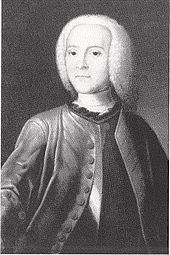Schlösslein colony
The so-called Schlösslein colony in Rehweiler in the Steigerwald in Lower Franconia was founded as a Pietist community settlement. The colony was established in 1734 by Count Ludwig Friedrich zu Castell-Remlingen . Today all buildings are under ensemble protection.
history
Beginnings (until 1735)
The prehistory of the settlement begins as early as 1720. In that year, the older Nikolaus Ludwig von Zinzendorf took on his younger cousin Ludwig Friedrich zu Castell-Remlingen as an educator when he was in Castell in Lower Franconia . During the count's studies, the two came closer together, so that in October 1730 Ludwig Friedrich stayed for the first time in Herrnhut, which had been founded by Zinzendorf as a pietistic congregation.
On July 12, 1732 Ludwig Friedrich was enfeoffed with the Grafschaft Castell in Würzburg . He had to share the rule with his older brothers Karl Friedrich Gottlieb, Wolfgang Georg II. And August Franz Friedrich. Then, in 1734, the count stayed again in Herrnhut and confirmed his conviction here to found a branch of the Brethren in Franconia. On September 1, 1734, Ludwig Friedrich acquired the Rehweiler estate in the Steigerwald as an allodial property from Johann Georg Wolfgang Hertel for 14,500 guilders .
During this planning phase, the count worked closely with Zinzendorf. First of all, the appropriate buildings had to be erected to accommodate the Pietist new settlers. For this purpose, the small castle colony was built, which initially consisted of six houses. In 1735 a school was housed in one of the houses . In the same year the construction of a hall church was tackled, but it was not completed until after the death of Ludwig Friedrich in 1774.
Another important building was erected in 1736 at the latest. It was an orphanage for boys and girls that could accommodate up to 40 children. At the same time, various preachers in Rehweiler began to convince people of pietism. Among them were August Gottlieb Spangenberg and Johann Adam Steinmetz , and the count himself also preached in Rehweiler. The well-known clergy attracted a large audience to the Steigerwaldort, the visitors came from Castell, Rüdenhausen and especially from Prichsenstadt and Eichfeld.
Peak and decline (until around 1745)
Count Ludwig Friedrich wanted to win a permanent preacher for his estate. Initially, Johann Georg Waiblinger from the pietistic stronghold of Ebersdorf was considered, but Zinzendorf suggested Magister Schmidlin from Tübingen to the count . However, Johann Pöschel from Ebersdorf did not become the first court preacher until 1738. Before that, on December 15, 1735, Nikolaus Ludwig von Zinzendorf visited the colony and thus caused an increase in the number of new residents in Rehweiler.
Count Lutz, as his subjects called him, had meanwhile doubted the continuation of the idea of a brother union in the Steigerwald. However, on a visit to Neustadt an der Aisch , Zinzendorf convinced him to finish the work he had started. He also guaranteed the count a private collection for Rehweiler, which was a great success, especially in Holland. In 1736 the influx of awakened people from the area reached its peak.
The next step was the settlement of Moravian brothers from the original community of Herrnhut. For this, Ludwig Friedrich had the area for the construction of buildings measured. In 1736, however, there was an open break between the Count and Zinzendorf. Ludwig Friedrich had visited the Pietists in Wernigerode who had spoken out against Zinzendorf. In the following months, Count Lutz tried to discuss it, but failed because of Zinzendorf.
After the end of the Pietist protection, the settlement began to decline. Earlier, however, Count Ludwig Friedrich tried to set up a printing company to publish leaflets and sermons on Pietism, but this project failed. In addition, the count's tight budgets put a strain on the settlement, which also became more and more orphaned due to many moves. Johann Friedrich zu Castell-Rüdenhausen , to whose territory Rehweiler actually belonged, also urged his distant relatives to give up pietism.
The count also lost more and more interest in his colony. He gradually distanced himself from the ideas of Pietism and turned to the Enlightenment. He also began with alchemical experiments. When Ludwig Friedrich became senior of the Castell family in 1770, he left the Steigerwalddorf to move to Castell. This marked the end of the settlement. Today the preserved buildings are classified as an ensemble by the State Office for Monument Preservation under the number D-6-75-127-55.
description
The Herrnhuter Schlösslein colony in Rehweiler consists of six symmetrically arranged hipped roof buildings from the 18th century, including the former school and the former orphanage. The buildings are graded according to size and importance and were built on the slope. The upper houses have drilled frames. House number 8 is marked with the year 1737.
literature
- Rudolf Kniewasser (ed.): Castell-Grafschaft and Dean's Office , Erlangen 1991
- Horst Weigelt: The relations between Ludwig Friedrich zu Castell-Remlingen and Zinzendorf as well as their correspondence. A contribution to the history of Moravian Pietism in Franconia . In: Helmut Baier (ed.): Individual works from the church history of Bavaria , Neustadt an der Aisch 1984
Individual evidence
- ↑ Weigelt, Horst: The Relationship Between Ludwig Friedrich zu Castell-Remlingen and Zinzendorf , p. 22
- ^ Rudolf Kniewasser (ed.): Castell-Grafschaft and Dean's Office , p. 83
- ^ Weigelt, Horst: The Relationship Between Ludwig Friedrich zu Castell-Remlingen and Zinzendorf , p. 43
Coordinates: 49 ° 46 ′ 3 " N , 10 ° 26 ′ 5.3" E


